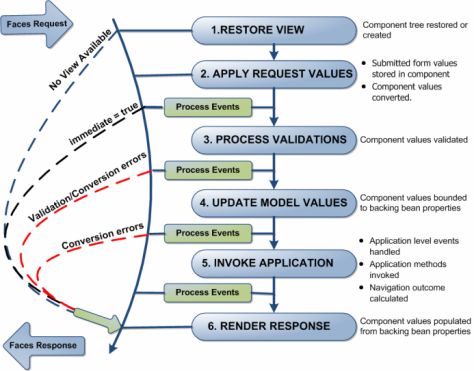Phase 1 : Restore view
In the RestoreView phase, JSF classes build the tree of UI components for the incoming request.
- When a request for a JavaServer Faces page is made, such as when a link or a button is clicked, the JavaServer Faces implementation begins the restore view phase.
- This is one of the trickiest parts of JSF: The JSF framework controller uses the view ID (typically JSP name) to look up the components for the current view. If the view isn’t available, the JSF controller creates a new one. If the view already exists, the JSF controller uses it. The view contains all the GUI components and there is a great deal of state management by JSF to track the status of the view – typically using HTML hidden fields.
- If the request for the page is an initial request, the JavaServer Faces implementation creates an empty view during this phase. Lifecycle only executes the restore view and render response phases because there is no user input or actions to process.
- If the request for the page is a postback, a view corresponding to this page already exists. During this phase, the JavaServer Faces implementation restores the view by using the state information saved on the client or the server. Lifecycle continues to execute the remaining phases.
- Fortunately this is the phase that requires the least intervention by application code.
Phase 3 : Process validations
The Apply Validations phase triggers calls to all registered validators.
- The components validate the new values coming from the request against the application’s validation rules.
- Any input can be scanned by any number of validators.
- These Validators can be pre-defined or defined by the developer.
- Any validation errors will abort the request–handling process and skip to rendering the response with validation and conversion error messages.
Phase 4 : Update Model Values
The Update Model phase brings a transfer of state from the UI component tree to any and all backing beans, according to the value expressions defined for the components themselves.
- It is in this phase that converters are invoked to parse string representations of various values to their proper primitive or object types. If the data cannot be converted to the types specified by the bean properties, the life cycle advances directly to the render response phase so that the page is re-rendered with errors displayed.
- Note: The difference between this phase and Apply Request Values – that phase moves values from client–side HTML form controls to server–side UI components; while in this phase the information moves from the UI components to the backing beans.
Phase 5 : Invoke Application
The Invoke Application phase handles any application-level events. Typically this takes the form of a call to process the action event generated by the submit button that the user clicked.
- Application level events handled
- Application methods invoked
- Navigation outcome calculated
Phase 6 : Render Response
Finally, Render Response brings several inverse behaviors together in one process:
- Values are transferred back to the UI components from the bean. Including any modifications that may have been made by the bean itself or by the controller.
- The UI components save their state – not just their values, but other attributes having to do with the presentation itself. This can happen server–side, but by default state is written into the HTML as hidden input fields and thus returns to the JSF implementation with the next request.
- If the request is a postback and errors were encountered during the apply request values phase, process validations phase, or update model values phase, the original page is rendered during this phase. If the pages contain
messageormessagestags, any queued error messages are displayed on the page.
Process Events
In this phase, any events that occurred during the previous phase are handled.
- Each Process Events phase gives the application a chance to handle any events (for example, validation failures) that occurred during the previous phase.
Note: Sometimes, an application might need to redirect to a different web application resource, such as a web service, or generate a response that does not contain JavaServer Faces components. In these situations, the developer must skip the rendering phase (Render Response Phase) by calling FacesContext.responseComplete. This situation is also shown in the diagram, with ProcessEvents pointing to the response arrow.
